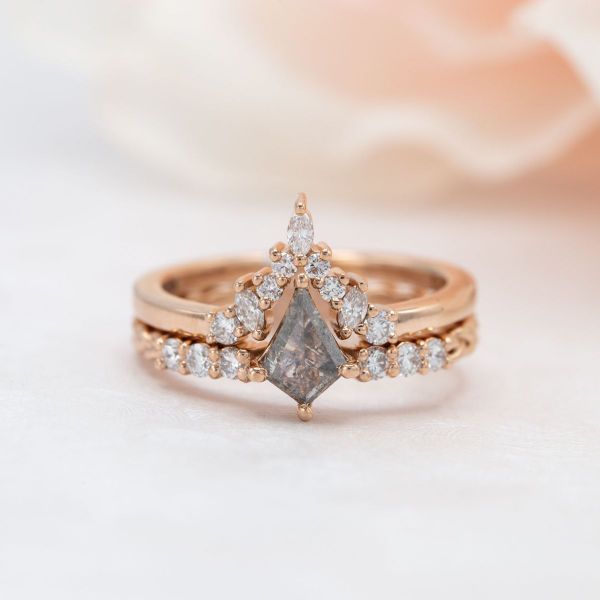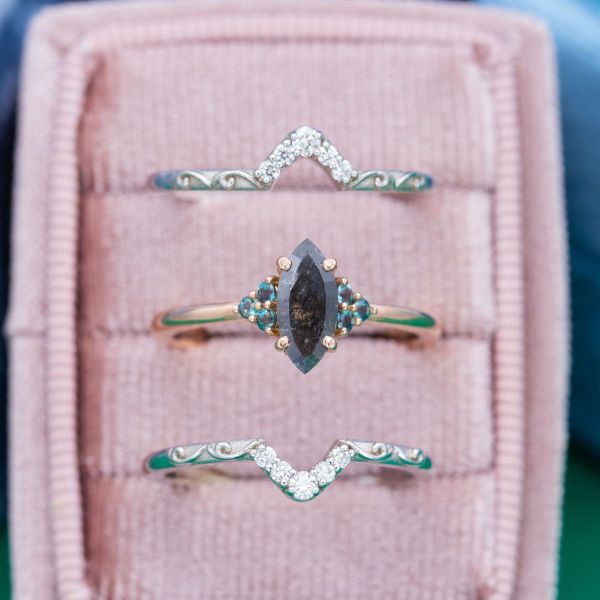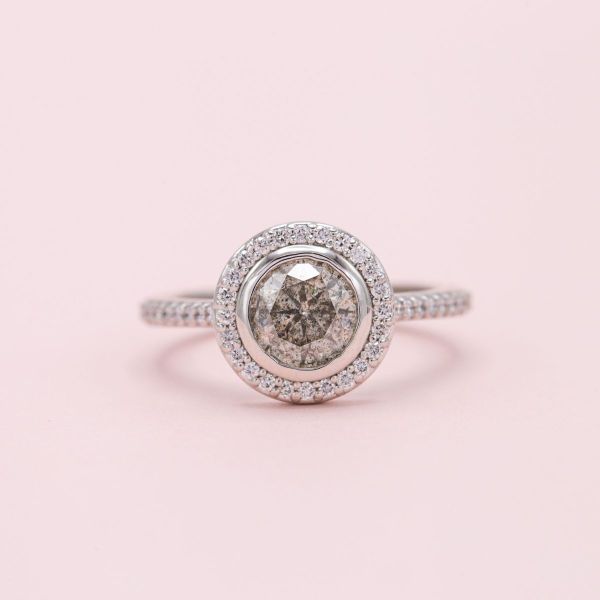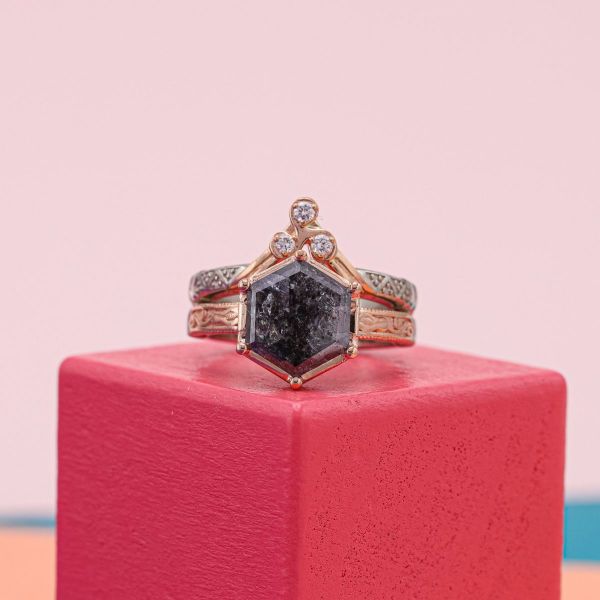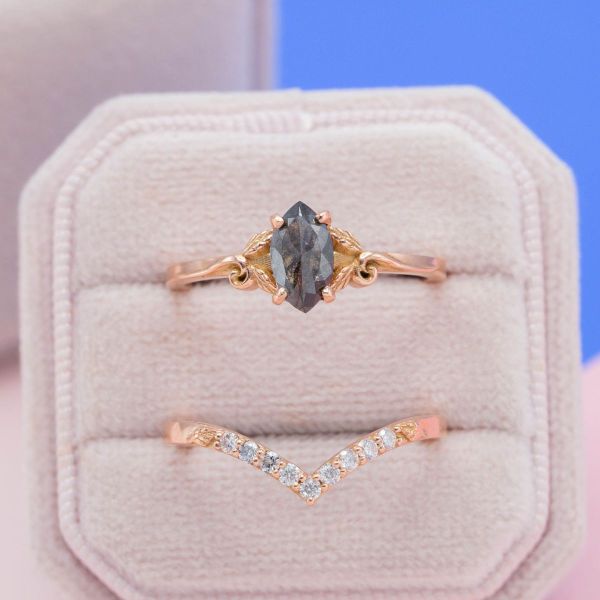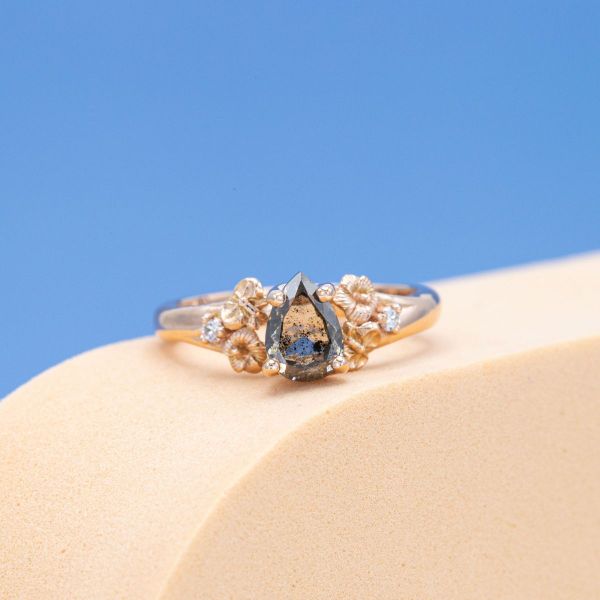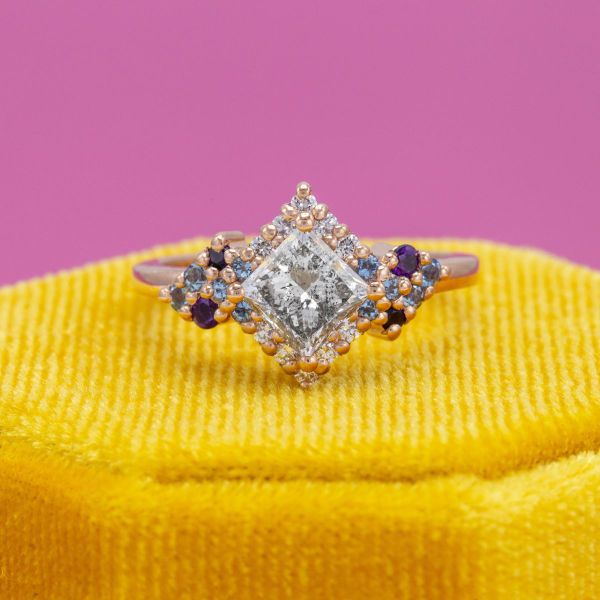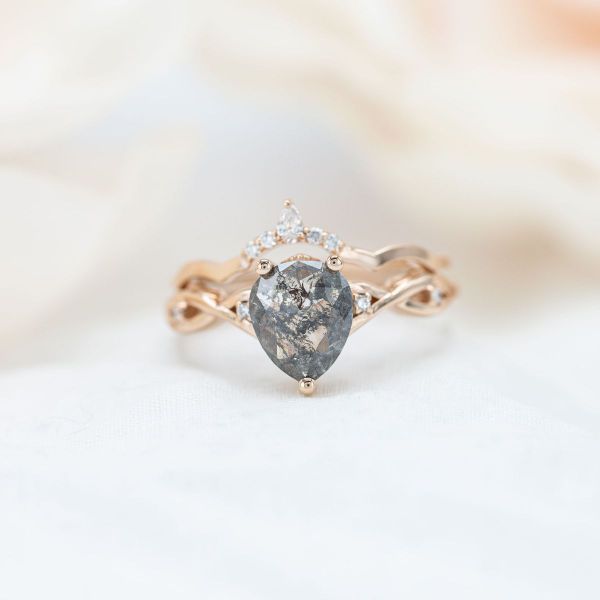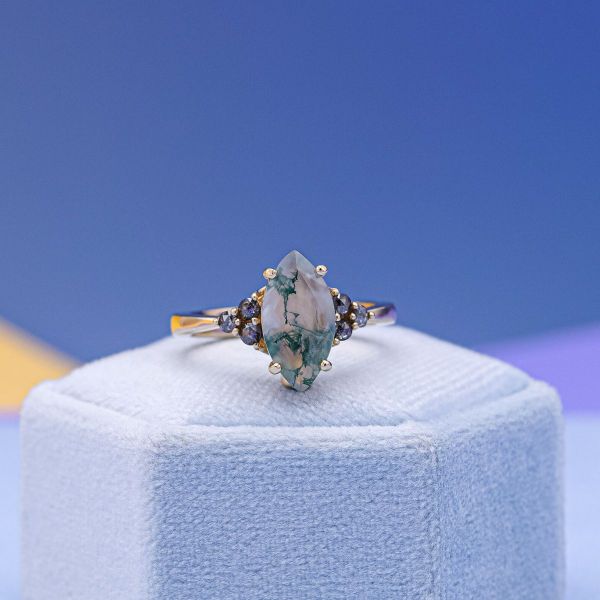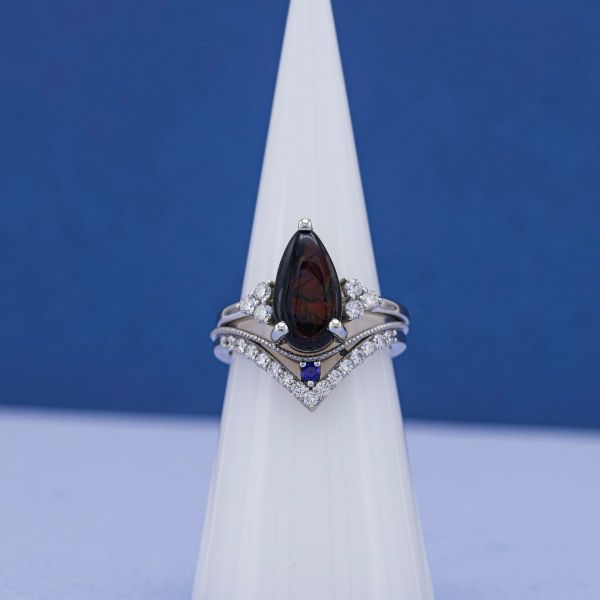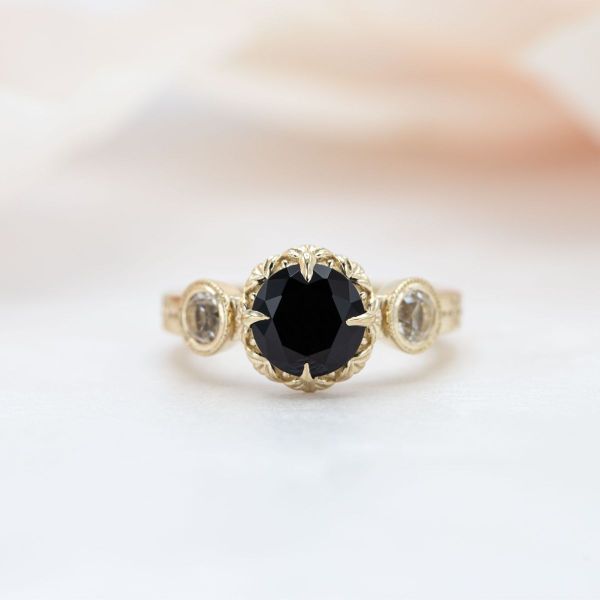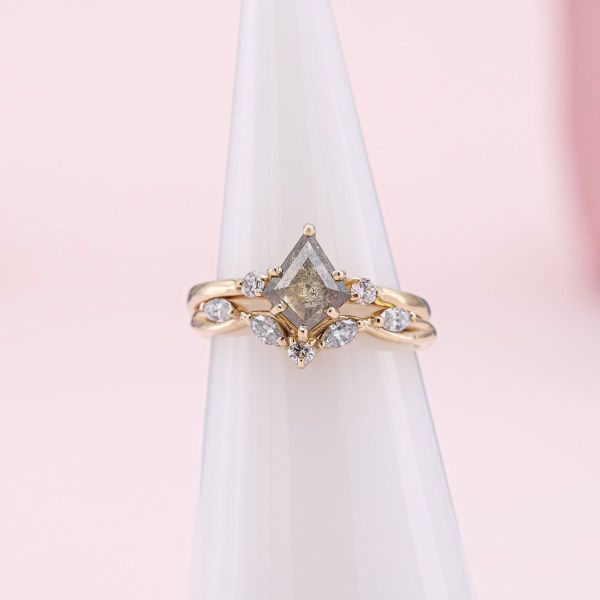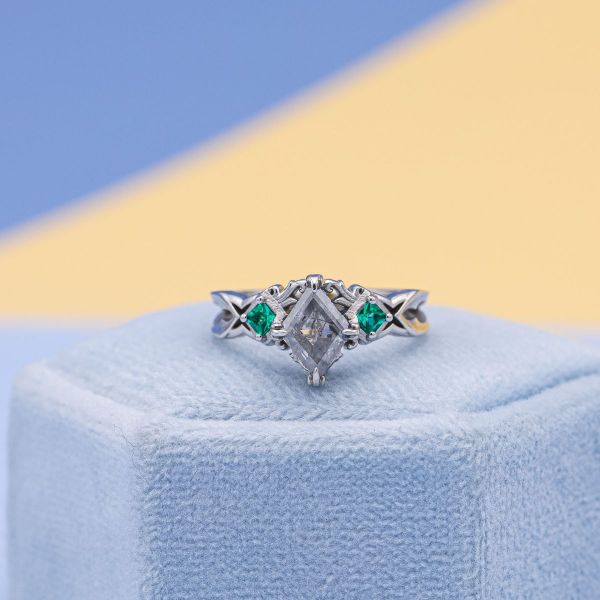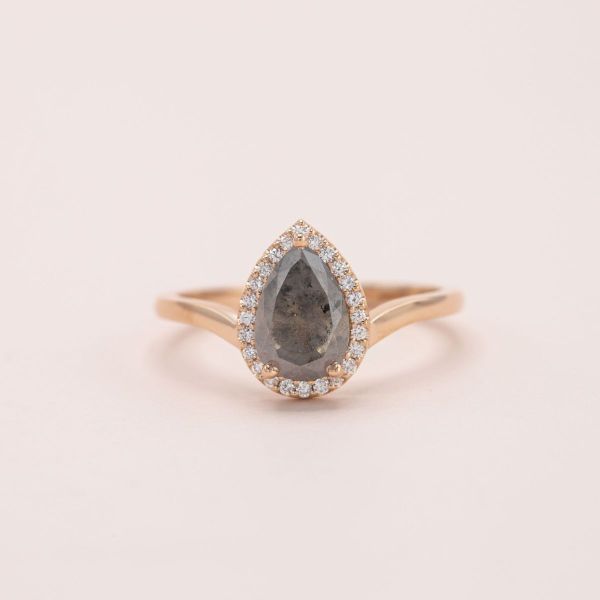Diamond Knowledge
What are salt and pepper diamonds?
A closer look at the visual variations you can expect from a salt and pepper diamond.
A spicy diamond for alternative engagement ring lovers
While many believe “diamonds are a girl’s best friend”, some couples seek an alternative to the sparkle of a classic white diamond while wanting similar durability and the “diamond” reputation. That’s where salt and pepper diamonds come in: black and white speckled stones with less of that typical sparkle and more of a glittering mystique. They’re 100% real diamonds, and their inclusions form entrancing swirls and spots of color that pull you under their spell, possibly like your gorgeous bride-to-be! While salt and pepper diamonds usually have a white, black, and gray palette, the stunning patterns and combinations these colors create make each one unique and ideal for a center stone in an engagement ring. Let’s take a closer look at the many visual variations you can expect from a salt and pepper diamond.
How do salt and pepper diamonds get their unique patterns?
Before we dive into the patterns and shades of silvery gray you can expect to see, let’s discuss how variations of salt and pepper diamonds even come to be. No two of these stones look the same, so where do these special diamonds get their one-of-a-kind look? Salt and pepper diamonds are filled with naturally occurring inclusions, and the density and type of imperfections within each stone produce a variety of colors, patterns, and more. There’s no one type of inclusion that makes a salt and pepper diamond, but rather their “diamond DNA” is a combination of all kinds of feathers, crystals, and spotted imperfections that make up a perfectly imperfect stone. However, for curious shoppers, many inclusions are made of graphite, carbon, hematite, and pyrite with occasional outliers.
These inclusions can also impact the opacity or translucence of salt and pepper diamonds. Opacity refers to how many wavelengths of light a gemstone absorbs or reflects, and the more light a stone absorbs the more opaque it is. For instance, a deep black stone, like onyx, would be opaque, as we can’t see the light moving through it. In turn, a translucent gemstone like a very light blue aquamarine transmits enough of those wavelengths of light that we can actually see them shining through the stone. Heavy or large inclusions can give salt and pepper diamonds an opaque, cloudy, or milky appearance, whereas smaller ones create that popular peppered look over a translucent backdrop.
All of these reasons are why salt and pepper diamonds can vary so widely! In fact, some even lack the typical patterned inclusions we associate with salt and pepper stones, making them look almost white or pale gray without that organic, chaotic look. Next, let’s look at some common patterns and colors these inclusions can create.
What colors and pattern variations can you expect from salt and pepper diamonds?
With a name like “salt and pepper”, we’re sure you’ve already figured out the main color scheme of these stones. However, you may also be asking yourself the age-old zebra question: are salt and pepper diamonds black with white stripes (inclusions), or white with black stripes (again, inclusions)? The answer is a little bit of both!
Most salt and pepper diamonds come in various shades of white, black, and gray, and typically the more inclusions the darker the overall color of the stone. Some salt and pepper stones even have streaks or specks of all three colors at once! The overall look can vary stone to stone, and no two are exactly alike. For example, some may only feature white or black inclusions, but others may have silky silver streaks splashed across a milky white stone.
While the pattern that’s right for you may also vary, one of the most sought after varieties of salt and pepper diamonds is a galaxy diamond. Also known as a celestial diamond, the body of these stones are heavily included, producing a dark gray or inky black background with tons of small white inclusions that look like stars dancing across the night sky. So romantic!
This design is a stark contrast to another popular style: salt and pepper diamonds with white backgrounds. Many couples love salt and pepper stones with a milky backdrop and black specs, which is practically the complete opposite of dark galaxy varieties. Whether you’re looking for a brooding galaxy salt and pepper diamond to propose to your beloved under a starry night sky or something a little brighter, our team at CustomMade can help you find the right pattern and color combination for your needs.
We already mentioned that salt and pepper diamonds can also be opaque or nearly translucent, with some taking on a milky white appearance and others looking more like a black diamond. On the other hand, some stones are translucent enough to see every little streak, splash, and speck. Your chosen stone may be mostly black, mostly white, or a little bit of both, but the mix of light and dark colors within a salt and pepper diamond creates a dynamic contrast that’s sure to impress.
It’s less common, but because inclusions are unpredictable when it comes to how they’ll impact a stone’s color, it’s not unheard of to see salt and pepper diamonds that have hints of yellow, green, red, orange, or even gold as well among the black and white mix. These colors may appear in the form of additional spots and swirls or a subtle undertone that gives the stone a slight colored appearance. This brings a whole new dimension to the sometimes monochrome appeal of salt and pepper stones, and some couples adore the gentle splash of extra color!
When it comes to salt and pepper diamonds, the possible patterns are truly endless. Be sure to look at plenty of different variations before making a final decision, as you may go into your search thinking you want a white stone with black and gray swirls and fall head over heels for a gray stone with white spots and a reddish undertone. Love is blind, after all!
Alternatives
We’ll level with you: there’s no other gemstone that completely replicates the allure of a salt and pepper diamond. Remember, they’re one-of-a-kind, so it’s hard to imagine another stone able to reproduce their bespoke appeal. But, don’t lose hope! If you’re not entirely sold on the idea of a diamond or aren’t afraid to try a little color, we have some fabulous alternatives for you to consider.
Moss agate
For couples seeking an alternative stone with a similar organic aesthetic, moss agate is a great option. Moss agate is a semi-transparent type of chalcedony with veins of gorgeous green inclusions that look like mossy vines or branches (hence the name!). These vibrant green inclusions make moss agate the perfect choice for the plant lover or friendly witch in your life. And much like salt and pepper diamonds, moss agate can vary widely with some stones having a white base with dark green veins and others so full of those lush lines that the entire stone looks like a mossy forest floor. Moss agate is also pretty durable at a 7 on the Mohs scale, so you can add it to your engagement ring without worry.
Opal
For lovers of that slightly chaotic, heavily included look, opals are a good alternative to salt and pepper diamonds. Opals known for their “play of color” or the rainbow flashes that move across the surface of the stone. In fact, these playful stones were once thought to be the result of lightning striking the earth!
Many opals have an opaque white or light body color that calls attention to those flashes of color. But, if you want something a little darker, black opals feature a dark body color for extra contrast against their rainbow color displays. Just a heads up: black opals are rare, so you may end up spending a bit more for this mysterious stone. You’ll also have to be more careful if you choose an opal as your center stone, since these delicate beauties are a 5 to 6.5 on the Mohs scale. However, a little extra care and a protective setting like a bezel or halo can go a long way in preserving your opal for decades to come.
Onyx
If you just can’t get the look of those inky black inclusions out of your head, you might want a jet black stone to match your mood. Another type of chalcedony, onyx is a relatively hard stone at a 7 on the Mohs scale, so it’s suitable for daily wear. It’s actually a very old gemstone, used in crafting cameos and jewelry for millennia! And it’s no surprise: this pitch black stone is as glittery as it is opaque for a darker take on the traditional center stone. Onyx can be faceted or cabbed (that means smooth with no facets), and it looks as amazing next to diamonds as it does colored gemstone accents.
Choosing your salt and pepper diamond
The black and white beauty of salt and pepper diamonds is hard to ignore, and we’re absolutely here for these spicy stones! Salt and pepper diamonds offer a unique take on the traditional diamond, providing couples a host of white, gray, and black color combinations to set their engagement ring apart from the crowd. And who knows: maybe you’ll be one of the lucky few who find a salt and pepper stone with hints of other colors! If you’re not quite sure salt and pepper diamonds are for you, just look at some of the lovely creations we’ve made for past clients featuring these bespeckled stones.
About CustomMade
CustomMade designs and creates one-of-a-kind, custom engagement rings and fine jewelry. Each piece we create is inspired by you, designed for you, and made just for you.
